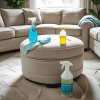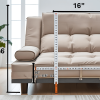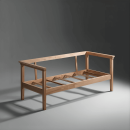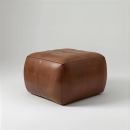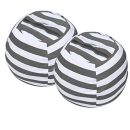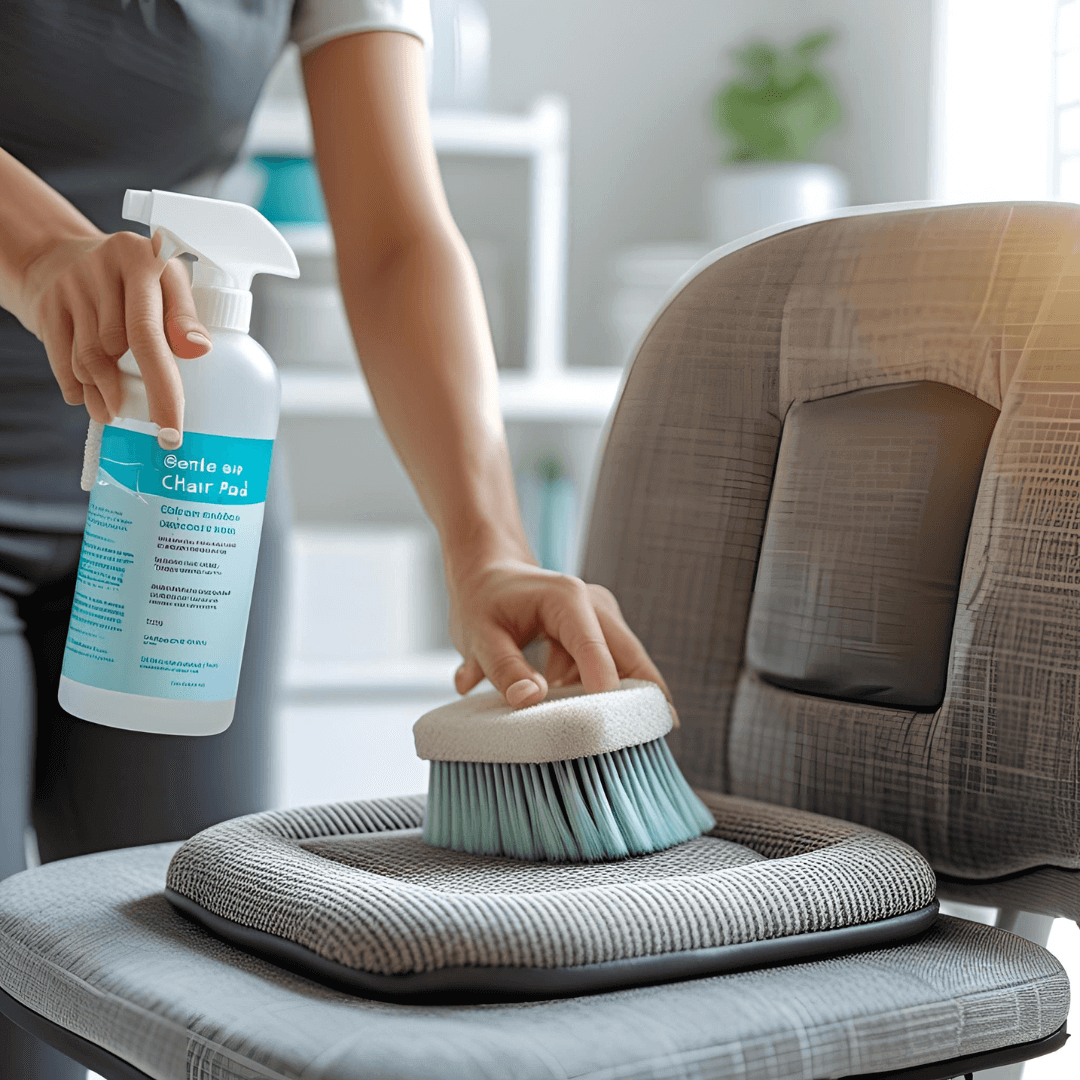
Can you wash chair pads? It’s a question you’ve probably asked yourself while staring at those food stains or mystery marks that won’t go away.
Chair pads are the unsung heroes of your home, providing comfort and style to your dining or living spaces. But let’s face it—life happens, spills are inevitable, and those pads can start looking less than inviting. The good news? You don’t have to live with the mess or toss them out just yet.
Before you grab the soap and water, though, the right way to clean them without ruining their shape, fabric, or cushion. Get it wrong, and you might end up with a lumpy or faded mess. But get it right, and your chair pads will look as fresh as the day you bought them. Curious to know how? Stick around, because this guide will walk you through everything you need to know to keep your chair pads clean, cozy, and long-lasting, without the stress. Let’s dive in!
Types Of Chair Pads
Chair pads add comfort and style to your seating areas. Over time, they can get dirty from spills, dust, and daily use. Washing chair pads is an easy way to keep them clean and fresh. Before cleaning, it’s important to understand the different types of chair pads. Each type has unique materials and care requirements. Knowing these details ensures you clean them correctly without damage.
Fabric Chair Pads
Fabric chair pads are the most common type. They are made from materials like cotton, polyester, or blends. These pads are often soft and easy to wash. Most fabric chair pads are machine-washable, but always check the care label for instructions.
- Use cold or warm water to avoid shrinking.
- Choose a gentle cycle for delicate fabrics.
- Air-dry or tumble-dry on low heat to prevent damage.
Tip: Pre-treat stains with mild detergent before washing to keep the fabric looking new.
Foam Chair Pads
Foam chair pads have a dense cushion for extra comfort. These pads often have removable covers, making cleaning easier. The foam insert should not be machine-washed as it may lose its shape.
- Remove the fabric cover if possible.
- Wash the cover according to the care label.
- Spot clean the foam insert with a damp cloth and mild soap.
Warning: Avoid soaking the foam as it takes too long to dry and can develop mold.
Memory Foam Chair Pads
Memory foam chair pads offer excellent support and comfort. They require extra care during cleaning. Washing memory foam in a machine can damage its structure.
| Step | Action |
|---|---|
| 1 | Remove the cover and wash separately. |
| 2 | Spot clean foam with a damp cloth. |
| 3 | Let the foam air-dry completely before reusing. |
Tip: Use a gentle cleaner to avoid damaging the foam’s texture.
Outdoor Chair Pads
Outdoor chair pads are made from weather-resistant materials like acrylic or polyester. These pads are designed to handle exposure to sunlight and rain. Cleaning outdoor chair pads is straightforward.
- Brush off dirt and debris before washing.
- Use warm water and mild soap for cleaning.
- Rinse thoroughly and air-dry in the shade.
Note: Avoid harsh chemicals, as they may weaken the fabric’s water-resistant coating.
Materials Used
Chair pads are a great addition to any seating area, offering comfort and style. But over time, they can accumulate dirt, stains, and odors. Washing chair pads can seem tricky, especially since the process often depends on the material they are made of. Understanding the materials used in chair pads is crucial to determine the proper cleaning method. Below, we’ll explore the most common materials used in chair pads and their washing guidelines.
Cotton
Cotton is a popular material for chair pads due to its softness, breathability, and natural feel. It’s also highly durable and easy to clean, making it a practical choice for everyday use. Most cotton chair pads are machine-washable, but it’s always best to check the label first.
Here are some tips for washing cotton chair pads:
- Use a gentle cycle with cold or warm water to avoid shrinking.
- Opt for a mild detergent to prevent fabric damage.
- Air dry the pads to retain their shape, or use a low-heat setting in the dryer.
If the cotton chair pad has a removable cover, the cleaning process becomes even easier. Unzip the cover and wash it separately. For stubborn stains, pretreat them by soaking the pad or cover in a mixture of water and a stain remover before washing.
| Pros | Cons |
|---|---|
| Soft and breathable | Prone to shrinking |
| Machine-washable | May fade over time |
Polyester
Polyester is another common material for chair pads. It is known for its durability and resistance to stains and wrinkles. Polyester chair pads are often easier to clean compared to natural materials like cotton. In most cases, they can be machine-washed, but specific care instructions may vary.
Steps to clean polyester chair pads:
- Check the care label for washing instructions.
- Wash using a gentle cycle with cold water.
- Avoid using harsh chemicals like bleach, as they can weaken the fibers.
- Dry the pads on low heat or air dry to prevent melting or deformation.
One of the best features of polyester is its quick-drying nature. This makes it an excellent option for families or busy households. Polyester is also resistant to most stains, so spot cleaning is often sufficient for minor messes.
| Pros | Cons |
|---|---|
| Durable and wrinkle-resistant | Can retain odors if not dried properly |
| Quick-drying | Less breathable than natural fabrics |
Foam
Foam is a common material used for chair pads due to its cushioning properties. Foam provides great support, but it can be trickier to clean compared to cotton or polyester. Foam chair pads are typically not machine-washable, as water can damage the foam’s structure and take a long time to dry.
Cleaning foam chair pads involves these steps:
- Remove the fabric cover, if applicable, and wash it separately.
- For the foam itself, use a damp cloth with mild soap to gently clean the surface.
- Allow the foam to air dry completely before reassembling the chair pad.
Never soak foam in water, as it can absorb and retain moisture, leading to unpleasant odors or mold growth. For tough stains, sprinkle baking soda on the foam, let it sit for a few hours, and vacuum it off. This method helps deodorize and clean without excessive moisture.
| Pros | Cons |
|---|---|
| Provides excellent support | Not machine-washable |
| Long-lasting | Can retain moisture |
Memory Foam
Memory foam is prized for its ability to contour to the body, offering unmatched comfort. It is a premium choice for chair pads, but cleaning it requires special care. Like regular foam, memory foam is not machine-washable, as water can ruin its structure and elasticity.
Follow these steps to clean memory foam chair pads:
- Remove the cover and wash it separately if possible.
- Spot clean the memory foam using a damp cloth and mild detergent.
- Blot the area with a dry towel to remove excess moisture.
- Allow the foam to air dry completely in a well-ventilated area.
Avoid wringing or twisting memory foam, as this can damage its shape. For odors, sprinkle the surface with baking soda, let it sit for a few hours, and vacuum it off. Memory foam pads should be cleaned sparingly to maintain their quality.
| Pros | Cons |
|---|---|
| Contours to the body for maximum comfort | Not machine-washable |
| Durable and long-lasting | Challenging to clean deeply |
Washing Instructions
Chair pads can make your seating more comfortable and stylish, but they also collect dirt, stains, and odors over time. Regular cleaning keeps them looking fresh and extends their lifespan. Washing chair pads may seem tricky, but the process is straightforward if you follow the right washing instructions. Below, you’ll learn how to clean chair pads using different methods: machine wash, hand wash, or dry cleaning. Let’s dive in!
Machine Wash
Cleaning chair pads in the washing machine is convenient and effective for most fabric-based pads. Before you begin, check the care label to ensure the pads are machine-washable. Some materials, like delicate fabrics or those with special finishes, may not be suitable for machine washing.
Follow these steps for machine washing chair pads:
- Remove covers (if detachable): If the chair pad has a removable cover, take it off before washing.
- Shake off debris: Shake out dust, crumbs, or loose dirt to avoid clogging the machine.
- Choose a gentle cycle: Use a delicate or gentle cycle to protect the fabric.
- Use cold water: Cold water prevents shrinking or fading, especially for colored fabrics.
- Add mild detergent: Avoid harsh detergents that could damage the material.
- Dry properly: Air-dry the pads or use a low-heat setting in the dryer if the label permits.
For added clarity, here’s a quick reference table:
| Step | Details |
|---|---|
| Water Temperature | Cold |
| Detergent Type | Mild |
| Cycle Type | Gentle/Delicate |
| Drying | Air-dry or Low Heat |
Always inspect the pads before putting them back on your chairs. Make sure they are scorched to prevent mold or mildew.
Hand Wash
If your chair pads are made of delicate materials or have non-removable covers, hand washing is a safer option. It’s also helpful for pads with intricate stitching or embellishments that could get damaged in a machine.
Here’s how to hand wash chair pads step by step:
- Prepare the cleaning solution: Fill a large basin or sink with lukewarm water and add a small amount of mild detergent.
- Soak the pads: Submerge the chair pads in the water and let them soak for 10-15 minutes to loosen dirt.
- Gently scrub: Use a soft sponge or cloth to scrub stains or heavily soiled areas. Avoid wringing the pads to keep their shape intact.
- Rinse thoroughly: Drain the soapy water and rinse the pads under clean, running water until no soap remains.
- Press out water: Gently press the pads between your hands or against the basin to remove excess water. Do not twist or wring them.
- Dry flat: Lay the pads flat on a clean towel in a well-ventilated area to air-dry.
Hand washing may take more time, but it’s worth the effort for fragile or high-maintenance materials. Make sure to dry the pads, before using them again.
Dry Cleaning
For chair pads made of fabrics like velvet, silk, or those with intricate designs, dry cleaning is the safest option. These materials can be damaged by water or harsh detergents, making dry cleaning a reliable alternative.
Here’s what you need to know about dry cleaning chair pads:
- Check the care label: Look for “Dry Clean Only” instructions on the label to confirm compatibility.
- Choose a professional cleaner: Take your chair pads to a trusted dry cleaner with experience handling home textiles.
- Inform about stains: Point out specific stains or spots to ensure they are treated properly.
- Ask about chemicals: Request eco-friendly or gentle cleaning solutions if you’re concerned about harsh chemicals.
Dry cleaning may cost more than other methods, but it ensures your delicate or high-end chair pads stay in great condition. It’s also an excellent choice for chair pads with foam inserts or non-removable covers that could be damaged in water-based cleaning methods.
Cleaning Tips
Chair pads can quickly accumulate dirt, stains, and odors due to everyday use. Whether they’re in your dining room, office, or patio, keeping them clean enhances their appearance and prolongs their lifespan. This guide provides practical and easy-to-follow cleaning tips to help you maintain chair pads effectively and ensure they always look and smell fresh.
Stain Removal
Stains are inevitable, especially on chair pads used in high-traffic areas or during meals. Removing them promptly prevents permanent damage. Here are simple methods to tackle various types of stains:
General Stains:
- Blot the stain with a clean, dry cloth to absorb excess liquid.
- Mix warm water with a mild detergent and gently scrub the stained area using a soft brush or sponge.
- Rinse the spot with clean water and allow it to air dry.
Grease Stains:
- Sprinkle baking soda on the stain to absorb the grease.
- After 15 minutes, brush off the baking soda and clean the area with a mix of dish soap and warm water.
- Rinse thoroughly and let it dry.
Ink or Dye Stains:
- Dab rubbing alcohol on a cotton ball and gently blot the stain.
- Repeat until the ink or dye starts to lift.
- Follow up with soap and water to clean the residue, then dry.
Table of Common Stain Solutions:
| Stain Type | Solution |
|---|---|
| Food stains | Mild detergent and water |
| Grease stains | Baking soda and dish soap |
| Ink stains | Rubbing alcohol |
Odor Elimination
Chair pads can develop unpleasant odors due to spills, sweat, or prolonged usage. Eliminating odors is straightforward with these tips:
Baking Soda Method:
- Sprinkle baking soda evenly over the chair pad surface.
- Let it sit for 30 minutes to absorb odors.
- Vacuum the pad thoroughly to remove the baking soda.
Vinegar Solution:
- Mix equal parts white vinegar and water in a spray bottle.
- Lightly mist the chair pad with the solution.
- Allow it to air dry in a well-ventilated area.
Essential Oils:
- Add a few drops of lavender or tea tree oil to your cleaning solution.
- This helps mask odors while disinfecting the fabric.
For persistent smells, consider steam cleaning. This method penetrates deep into the fabric to neutralize odors effectively. Always test cleaning solutions on a small, hidden area first to avoid damage.
Regular Maintenance
Regular care keeps chair pads looking fresh and functional for years. Incorporate these habits into your routine:
Weekly Cleaning:
- Vacuum chair pads weekly to remove dust, crumbs, and debris.
- Spot clean minor spills immediately to prevent stains.
Monthly Deep Cleaning:
- Remove chair pads and inspect for dirt or damage.
- Wash removable covers in the washing machine using a gentle cycle.
- For non-removable pads, hand wash with mild soap and water.
Protective Measures:
- Use slipcovers or fabric protectors to shield pads from stains and spills.
- Rotate chair pads regularly to ensure even wear.
Consistent maintenance enhances appearance and extends the life of your chair pads. Dedicate a few minutes each week to keep them in top condition.
Drying Methods
Chair pads can instantly elevate the comfort of your seating, but keeping them clean is essential. After washing, drying them properly is just as important as cleaning. The drying method you choose can significantly affect the longevity of your chair pads. Below, we explore different drying methods to ensure your chair pads stay fresh, fluffy, and damage-free.
Air Drying
Air drying is one of the safest methods for drying chair pads. It helps to maintain the shape and texture of the fabric while avoiding heat-related damage. This method is for delicate materials or chair pads with intricate designs. Here are some tips for effective air drying:
- After washing, press the pads gently to remove excess water. Avoid wringing them, as this can distort their shape.
- Place the chair pads on a flat surface, preferably on a drying rack or a clean towel.
- Ensure the drying area is well-ventilated to speed up the process and prevent mildew.
- Flip the pads occasionally to allow even drying on both sides.
Drying time will vary based on fabric type and room conditions. Cotton pads may dry faster than thicker, foam-filled ones.
Use the table below as a quick reference for drying times:
| Material | Approximate Air Drying Time |
|---|---|
| Cotton | 4-6 hours |
| Foam-filled | 8-12 hours |
| Polyester | 6-8 hours |
Pro Tip: Avoid direct sunlight, as it may cause colors to fade over time. Choose a shaded area instead.
Tumble Drying
Tumble drying is a faster option, but it requires caution to prevent damage. Before using this method, confirm whether the chair pad’s care label permits machine drying. Follow these steps for a safe tumble drying process:
- Set the dryer to a low heat or delicate setting. High heat can shrink or damage the fabric.
- Place a couple of clean tennis balls or dryer balls in the machine to keep the pads fluffy.
- Check the pads every 15-20 minutes to ensure they are drying evenly and not overheating.
- Remove the pads while they are slightly damp to finish air drying. This minimizes wrinkles and prevents over-drying.
Some chair pads, especially foam-filled ones, may not tolerate tumble drying well. Always prioritize the instructions on the care label. Tumble drying can save time, but should only be used if the material permits it.
Important Reminder: Avoid overloading the dryer. Too many items can lead to uneven drying and increase the risk of heat damage.
Avoiding Heat Damage
Heat damage can ruin chair pads by shrinking the fabric, melting synthetic fibers, or distorting foam inserts. Whether air drying or tumble drying, keeping heat exposure minimal is key. Below are some tips to prevent heat damage:
- Check the care label: Always read the manufacturer’s instructions before choosing a drying method.
- Use low heat settings: For tumble drying, low or no heat settings are safest for most materials.
- Avoid direct sunlight: Prolonged exposure to sunlight can weaken fibers and fade colors.
- Test drying times: If unsure, dry for shorter intervals and check the pads frequently.
If you’re using a heated iron or steamer to remove wrinkles, place a thin cloth between the iron and the chair pad. Direct heat can scorch the material or leave permanent marks. For foam-filled pads, avoid any contact with high heat altogether, as foam is highly sensitive to temperature changes.
Quick Tip: If a chair pad feels hot to the touch during drying, stop the process immediately and allow it to cool before continuing.
When To Replace
Chair pads can bring comfort and style to your seating, but they endure daily wear and tear. Over time, they may lose their shape, become stained, or show signs of damage. Washing chair pads can help maintain their appearance, but it’s not always enough. Understanding when to replace chair pads ensures your seating remains both functional and attractive.
1. Signs Of Wear And Tear
Inspect your chair pads regularly for visible damage. Common signs include:
- Flat or lumpy padding: Reduced cushioning can make seating uncomfortable.
- Frayed edges or loose stitching: These can worsen with time and use.
- Permanent stains: Stains that washing can’t remove may indicate it’s time for replacement.
If the wear affects comfort or aesthetics, replacing the pads is a smart choice.
2. Loss Of Support
Chair pads are designed to provide support during seating. Over time, the filling can compress, leading to discomfort. Test the pad by sitting on it:
- If the pad feels hard or provides no cushioning, it’s no longer effective.
- A sagging or uneven feel can also signal the need for a new pad.
Comfort is key. Don’t wait too long to upgrade.
3. Odor That Won’t Go Away
Persistent odors can make your chair pads unpleasant to use. Over time, spills, sweat, and dirt can cause smells that even washing can’t remove. If the odor lingers even after cleaning, it may be time to replace the pads.
4. Change In Style Or Decor
Sometimes, replacement isn’t about damage but about personal preference. Chair pads that no longer match your decor can make your space feel outdated. Updating your pads with fresh designs and colors can instantly improve your room’s look.
5. Lifespan Of Chair Pads
On average, chair pads last 2 to 3 years, depending on usage and quality. Pads used frequently may wear out sooner. If your chair pads have passed this timeframe, assess their condition.
Even if they seem fine, replacing them can improve comfort and style.
| Condition | Action |
|---|---|
| Visible damage or stains | Replace |
| Flat or uneven padding | Replace |
| Lingering odor | Replace |
| Still functional but outdated | Optional replacement |
Replacing chair pads at the right time ensures comfort, hygiene, and a refreshed look for your space.
Eco-friendly Options
Chair pads often face wear and tear from daily use, spills, and stains. Washing them not only restores their appearance but also extends their lifespan. Choosing eco-friendly options for cleaning chair pads can reduce environmental impact and promote sustainable living. Below are practical and eco-friendly solutions for cleaning chair pads while considering the environment.
Use Plant-based Detergents
Switching to plant-based detergents is a simple way to clean chair pads. These detergents are free from harsh chemicals and biodegradable. They are gentle on fabrics and safe for the environment. Look for products labeled as “eco-friendly” or “non-toxic.”
Cold Water Cleaning
Washing chair pads in cold water saves energy compared to heated cycles. Cold water is effective in removing dirt and stains when combined with proper detergent. It also prevents color fading and fabric damage.
Air Drying Techniques
Skip the dryer and opt for air drying to reduce electricity consumption. Lay chair pads flat in a shaded area or hang them on a clothesline. Air drying preserves fabric integrity and reduces carbon emissions.
Diy Green Cleaning Solutions
Homemade cleaning solutions can be eco-friendly and cost-effective. Mix baking soda and water to create a paste for spot cleaning. Use white vinegar diluted with water to freshen chair pads. These natural ingredients are safe and readily available.
Recyclable Chair Pad Covers
Consider using chair pad covers made from recycled materials. These covers protect the pad and can be machine-washed without harming the environment. Look for brands that focus on sustainable production.
Table: Eco-friendly Cleaning Tips
| Cleaning Option | Environmental Benefit | Ease of Use |
|---|---|---|
| Plant-Based Detergents | Non-toxic and biodegradable | Easy to find in stores |
| Cold Water Washing | Reduces energy consumption | Requires no special equipment |
| Air Drying | Cut electricity use | Simple and effective |
| DIY Solutions | Uses natural ingredients | Budget-friendly |
| Recyclable Covers | Promotes sustainability | Protects chair pads |
How To Clean Chair Pads Without Removing Cover?
Chair pads can accumulate dust, spills, and stains over time, but cleaning them can feel challenging, especially if the covers are non-removable. Whether you’re dealing with accidental food spills or general wear, it’s possible to freshen up your chair pads without removing the cover. By using the right techniques, you can maintain their appearance and extend their lifespan. Let’s explore the best ways to clean chair pads without detaching the covers.
1. Vacuum The Surface Thoroughly
Start by vacuuming the chair pad to remove loose dirt, crumbs, and pet hair. Use a handheld vacuum or a vacuum cleaner with an upholstery attachment for better control. Make sure to reach the corners and seams where dust often hides. A clean surface makes the following steps more effective.
2. Spot Clean Stains Immediately
For fresh stains, blot the area with a clean cloth or paper towel to absorb excess liquid. Mix a small amount of mild detergent with warm water. Dip a soft cloth or sponge into the solution and gently dab the stain. Avoid soaking the fabric to prevent water from seeping into the pad’s inner layers.
3. Use A Fabric Cleaner Spray
Choose a fabric-safe cleaner designed for upholstery. Lightly spray it over the chair pad, focusing on stained or dirty areas. Follow the product instructions for the best results. After spraying, use a clean microfiber cloth to wipe the surface in circular motions. This helps lift dirt without damaging the fabric.
4. Steam Clean For Deep Cleaning
If the chair pad feels grimy, steam cleaning is a safe option. Use a handheld steam cleaner or an upholstery attachment on a larger steamer. Hold the steam nozzle a few inches above the fabric and move it slowly over the surface. Steam kills bacteria and loosens dirt effectively without soaking the pad.
5. Sprinkle Baking Soda For Odor Removal
To freshen up chair pads, sprinkle a thin layer of baking soda over the surface. Let it sit for 15-20 minutes to absorb odors and moisture. Afterward, vacuum the baking soda thoroughly to leave the chair pad smelling clean and refreshed.
6. Air Dry The Chair Pads
After cleaning, allow the chair pads to air dry completely. Place them in a well-ventilated area, away from direct sunlight, which can fade the fabric. Avoid using the chair pads until they are scorched to prevent mold or mildew.
Quick Reference Table: Cleaning Chair Pads Without Removing Covers
| Step | Action | Tools Needed |
|---|---|---|
| 1 | Vacuum Surface | Handheld Vacuum, Upholstery Attachment |
| 2 | Spot Clean Stains | Mild Detergent, Soft Cloth |
| 3 | Use Fabric Cleaner | Upholstery Spray, Microfiber Cloth |
| 4 | Steam Clean | Handheld Steam Cleaner |
| 5 | Sprinkle Baking Soda | Baking Soda, Vacuum |
| 6 | Air Dry | Well-Ventilated Space |
Frequently Asked Questions
Can You Machine Wash Chair Pads?
Yes, most chair pads can be machine washed. Check the care label for instructions. Use a gentle cycle and mild detergent.
How Often Should You Wash Chair Pads?
Wash chair pads every few months or as needed. Frequency depends on usage, spills, and overall cleanliness.
What Is The Best Way To Dry Chair Pads?
Air drying is ideal for chair pads. Lay them flat to prevent distortion. Avoid high heat to maintain their shape.
Can Stains On Chair Pads Be Removed Easily?
Yes, most stains can be removed. Pre-treat with stain remover and wash as directed. Avoid harsh chemicals.
Conclusion
Cleaning chair pads doesn’t have to be complicated. Check the care label first. Some pads can be machine washed, others need spot cleaning. Use mild detergent to protect the fabric and colors. Dry them completely to prevent mold or odors.
Regular cleaning keeps them fresh and comfortable for everyday use. Always handle delicate materials with damage. With the right approach, maintain your chair pads and stay stress-free. Keep these tips in mind, and your chair pads will last longer while staying clean and cozy.

